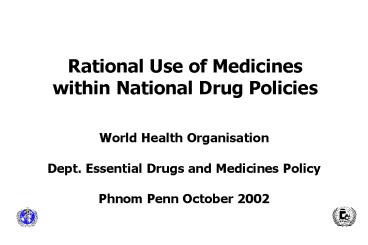Rational Use of Medicines within National Drug Policies - PowerPoint PPT Presentation
1 / 20
Title:
Rational Use of Medicines within National Drug Policies
Description:
often not implemented due to lack of political will and corruption ... 10-90% Shigella resistant to ampicillin and cotrimoxazole ... – PowerPoint PPT presentation
Number of Views:101
Avg rating:3.0/5.0
Title: Rational Use of Medicines within National Drug Policies
1
Rational Use of Medicines within National Drug
Policies
- World Health OrganisationDept. Essential Drugs
and Medicines PolicyPhnom Penn October 2002
2
A National Medicines Policyoften not implemented
due to lack of political will and corruption
- Expresses the goals and objectives set by a
government for the pharmaceutical sector and
identifies the main strategies for achieving them - specifies the roles of all stakeholders (public
and private) - specifies government aims, decisions
commitments - should be concerned with
- equitable access,
- ensuring drugs are of good quality, safety and
efficacy, - promoting correct use of drugs
3
Every country needs a national drug policy
because of
- medical reasons
- 25-40 of the world population has no access to
drugs - up to 50 of the worlds drugs may be used
inappropriately - substandard and counterfeit drugs are not
infrequent - cost reasons
- drugs are 20-40 of health budgets - antibiotics
injections are most expensive - the need for coordinated multiple interventions
- single interventions do not change behaviour
long-term
4
30 to 60 of PHC patients receive antibiotics -
perhaps twice what is clinically needed
2 - 40 primary multi-drug resistant TB 5 - 98
N.Gonorrhoea resistant to penicillin 10-90
Shigella resistant to ampicillin and cotrimoxazole
of PHC patients receiving antibiotics
5
viral URTI cases treated with antibiotics
ARI programme health facility survey
12 - 55 penicillin resistance in S. pneumoniae
also in ARI survey with a similar result (53
vs. 55, both in 1994) also in ARI survey with
a very different result (8 in 1994 vs. 97 in
1997)
6
5-50 of PHC patients receive injections up to
90 may be medically unnecessary
- 15 billion injections per year globally
- half are with unsterilized needle/syringe
- 2.3-4.7 million infections of hepatitis B/C and
up to 160,000 infections of HIV per year
associated with injections
of primary care patients receiving injections
Source Quick et al, 1997, Managing Drug Supply
7
prescriptions conforming to STGs estimated
from expected versus actual no.items per
prescription
8
drugs that are prescribed unnecessarilyestimate
d by a comparison of expected versus actual
prescriptionChalker HPP 1996, Hogerzeil et al
Lancet 1989, Isah et al 2000
9
Many Factors Influence Use of Medicines
10
Changing a Drug Use ProblemAn Overview of the
Process
11
Strategies to Improve Use of Drugs
- Managerial
- Guide clinical practice
- Information systems/STGs
- Drug supply / lab capacity
- Educational
- Inform or persuade
- Health providers
- Consumers
- Economic
- Offer incentives
- Institutions
- Providers and patients
- Regulatory
- Restrict choices
- Market or practice controls
- Enforcement
12
of ARI cases in children lt 5 years in Fiji
treated with antibiotics after ARI prog.
implemented
ARI 5th programme report, WHO Geneva, 1990-1
13
Impact of multiple interventions on injection use
in Indonesia
Source Long-term impact of small group
interventions, Santoso et al., 1996
14
No.drugs
Antibiotics
Injections
15
RCT in Uganda of the effects of STGs, training
supervision on the of Px conforming to
STGsKafuko et al, UNICEF, 1996.
16
Tetracycline Prescription Rate Denmark Jan.1994-
Feb.1999
prescriptions per 1,000 inhab.
Change in subsidization from 50 to 0
Month
Source Danish Medicines Agency, 1999.
17
Review of 30 studies in developing countries
size of drug use improvements with different
interventions
None/minor
Moderate
Large
Large group training
Small group training
Diarrhoea community case mgt
ARI community case mgt
Info/guidelines
Group process
Supervision/audit
EDP/Drug supply
Economic strategies
0
10
20
30
40
50
60
Improvement in outcome measure ()
Source Ross-Degnan et al, Plenary presentation,
Conference on Improving the Use of
Medicines, 1997, Chiang Mai, Thailand.
18
Promoting RUD through National Drug Policy (1)
- Mandated multi-disciplinary body
- subcommittee of NDP to coordinate RUD policies
and to monitor and evaluate drug use - Legislation and Regulations
- independent drug regulatory body with adequate
manpower and funds - reduce inappropriate medicine use through
regulation of drug promotion - reduce inappropriate medicine availability and
use through - drug registration and market withdrawal of
inappropriate drugs - licensing of drug outlets and health
professionals - limiting certain medicines to prescription-only
19
Promoting RUD through National Drug Policy (2)
- Drug selection and supply
- evidence-based selection of drugs for public
sector (EDL) - increasing appropriate availability through
effective local production, procurement,
distribution, storage - Drug Financing, Pricing and Economic strategies
- avoid perverse incentives e.g. prescribers
selling drugs - reduce taxes, tariffs, distribution margins on
appropriate drugs - reimburse (insurance or public sector)
appropriate drugs - Human resource development
- define role of health professions, minimum
education/training requirements for staff, and
pre- and in-service training
20
Promoting RUD through National Drug Policy (3)
- Provider and consumer education
- develop evidence-based STGs
- provide unbiased information
- undergraduate and continuing medical education
- Licensure requirements?
- Problem-based pharmacotherapy
- establish and support drug therapeutic
committees - public education campaigns
- Monitoring and Evaluation
- Define and support sustainable mechanisms for
monitoring, supervision and evaluation































